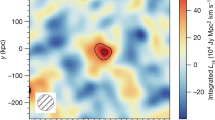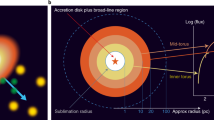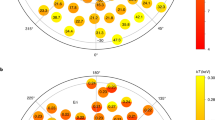Abstract
Every star-forming galaxy has a halo of metal-enriched gas that extends out to at least 100 kiloparsecs1,2,3, as revealed by the absorption lines that this gas imprints on the spectra of background quasars4. However, quasars are sparse and typically probe only one narrow beam of emission through the intervening galaxy. Close quasar pairs5,6,7 and gravitationally lensed quasars8,9,10,11 have been used to circumvent this inherently one-dimensional technique, but these objects are rare and the structure of the circumgalactic medium remains poorly constrained. As a result, our understanding of the physical processes that drive the recycling of baryons across the lifetime of a galaxy is limited12,13. Here we report integral-field (tomographic) spectroscopy of an extended background source—a bright, giant gravitational arc. We can thus coherently map the spatial and kinematic distribution of Mg ɪɪ absorption—a standard tracer of enriched gas—in an intervening galaxy system at redshift 0.98 (around 8 billion years ago). Our gravitational-arc tomography unveils a clumpy medium in which the absorption strength decreases with increasing distance from the galaxy system, in good agreement with results for quasars. Furthermore, we find strong evidence that the gas is not distributed isotropically. Interestingly, we detect little kinematic variation over a projected area of approximately 600 square kiloparsecs, with all line-of-sight velocities confined to within a few tens of kilometres per second of each other. These results suggest that the detected absorption originates from entrained recycled material, rather than in a galactic outflow.
This is a preview of subscription content, access via your institution
Access options
Access Nature and 54 other Nature Portfolio journals
Get Nature+, our best-value online-access subscription
$29.99 / 30 days
cancel any time
Subscribe to this journal
Receive 51 print issues and online access
$199.00 per year
only $3.90 per issue
Buy this article
- Purchase on Springer Link
- Instant access to full article PDF
Prices may be subject to local taxes which are calculated during checkout




Similar content being viewed by others
References
Churchill, C. W. et al. Low- and high-ionization absorption properties of Mg ɪɪ absorption-selected galaxies at intermediate redshifts. I. General properties. Astrophys. J. Suppl. Ser. 130, 91–119 (2000)
Chen, H.-W. et al. An empirical characterization of extended cool gas around galaxies using Mg ɪɪ absorption features. Astrophys. J. 714, 1521–1541 (2010)
Nielsen, N. M., Churchill, C. W. & Kacprzak, G. G. MAGIICAT II. General characteristics of the Mg ɪɪ absorbing circumgalactic medium. Astrophys. J. 776, 115 (2013)
Chen, H.-W. in Outskirts of Galaxies (eds Knapen, J. et al.) 291–331 (Springer, 2017)
Tytler, D. et al. Metal absorption systems in spectra of pairs of QSOs: how absorbers cluster around QSOs and other absorbers. Mon. Not. R. Astron. Soc. 392, 1539–1572 (2009)
Martin, C. L. et al. The size and origin of metal-enriched regions in the intergalactic medium from spectra of binary quasars. Astrophys. J. 721, 174–192 (2010)
Hennawi, J. F. et al. Binary quasars in the Sloan Digital Sky Survey: evidence for excess clustering on small scales. Astron. J. 131, 1–23 (2006)
Rauch, M., Sargent, W. L. W., Barlow, T. A. & Carswell, R. F. Small-scale structure at high redshift. III. The clumpiness of the intergalactic medium on subkiloparsec scales. Astrophys. J. 562, 76–87 (2001)
Lopez, S., Ellison, S., D’Odorico, S. & Kim, T.-S. Clues to the nature of high-redshift O vi absorption systems from their lack of small-scale structure. Astron. Astrophys. 469, 61–74 (2007)
Chen, H.-W. et al. Spatially resolved velocity maps of halo gas around two intermediate-redshift galaxies. Mon. Not. R. Astron. Soc. 438, 1435–1450 (2014)
Rubin, K. H. R. et al. Andromeda’s parachute: a bright quadruply lensed quasar at z = 2.377. Preprint at https://arxiv.org/abs/1707.05873 (2017)
Kereš, D., Katz, N., Weinberg, D. H. & Davé, R. How do galaxies get their gas? Mon. Not. R. Astron. Soc. 363, 2–28 (2005)
Muratov, A. L. et al. Gusty, gaseous flows of FIRE: galactic winds in cosmological simulations with explicit stellar feedback. Mon. Not. R. Astron. Soc. 454, 2691–2713 (2015)
Bacon, R. et al. The MUSE second-generation VLT instrument. Proc. SPIE 7735, 773508 (2010)
Wuyts, E. et al. A bright, spatially extended lensed galaxy at z = 1.7 behind the cluster RCS2 032727–132623. Astrophys. J. 724, 1182–1192 (2010)
Dahle, H. et al. Discovery of an exceptionally bright giant arc at z = 2.369, gravitationally lensed by the Planck cluster PSZ1 G311.65–18.48. Astron. Astrophys. 590, L4 (2016)
Rigby, J. R., Wuyts, E., Gladders, M. D., Sharon, K. & Becker, G. D. The physical conditions of a lensed star-forming galaxy at z = 1.7. Astrophys. J. 732, 59 (2011)
Rigby, J. R. et al. The Magellan Evolution of Galaxies Spectroscopic and Ultraviolet Reference Atlas (MEGaSaURA) I: the sample and the spectra. Astrophys. J. Suppl. Ser. (in the press)
Nielsen, N. M., Churchill, C. W., Kacprzak, G. G. & Murphy, M. T. MAGIICAT I. The Mg ɪɪ absorber-galaxy catalog. Astrophys. J. 776, 114 (2013)
Lopez, S. et al. Metal abundances in a damped Lyα system along two lines of sight at z = 0.93. Astrophys. J. 626, 767–775 (2005)
Ellison, S. L. An efficient technique for pre-selecting low-redshift damped Lya systems. Mon. Not. R. Astron. Soc. 368, 335–340 (2006)
Tumlinson, J. et al. The COS-Halos Survey: rationale, design, and a census of circumgalactic neutral hydrogen. Astrophys. J. 777, 59 (2013)
Ho, S. H., Martin, C. L., Kacprzak, G. G. & Churchill, C. W. Quasars probing galaxies. I. Signatures of gas accretion at redshift approximately 0.2. Astrophys. J. 835, 267 (2017)
Steidel, C. C. in QSO Absorption Lines (ed. Meylan, G. ) 139–152 (Springer, 1995)
Charlton, J. C. & Churchill, C. W. Mg ɪɪ absorbing galaxies: halos or disks? Astrophys. J. 465, 631–645 (1996)
Bouché, N. et al. Physical properties of galactic winds using background quasars. Mon. Not. R. Astron. Soc. 426, 801–815 (2012)
Kacprzak, G. G., Churchill, C. W. & Nielsen, N. M. Tracing outflows and accretion: a bimodal azimuthal dependence of Mg ɪɪ absorption. Astrophys. J. 760, L7 (2012)
Bordoloi, R., Lilly, S. J., Kacprzak, G. G. & Churchill, C. W. Modeling the distribution of Mg ɪɪ absorbers around galaxies using background galaxies and quasars. Astrophys. J. 784, 108 (2014)
Kacprzak, G. G. in Gas Accretion onto Galaxies (eds Fox, A. & Davé, R. ) 145–165 (Springer, 2017)
Muratov, A. L. et al. Metal flows of the circumgalactic medium, and the metal budget in galactic haloes. Mon. Not. R. Astron. Soc. 468, 4170–4188 (2017)
Soto, K. T., Lilly, S. J., Bacon, R., Richard, J. & Conseil, S. ZAP – enhanced PCA sky subtraction for integral field spectroscopy. Mon. Not. R. Astron. Soc. 458, 3210–3220 (2016)
Cappellari, M. & Copin, Y. Adaptive spatial binning of integral-field spectroscopic data using Voronoi tessellations. Mon. Not. R. Astron. Soc. 342, 345–354 (2003)
Robertson, J. G. Optimal extraction of single-object spectra from observations with two-dimensional detectors. Publ. Astron. Soc. Pacif. 98, 1220–1231 (1986)
Rigby, J. R. et al. C ɪɪɪ emission in star-forming galaxies near and far. Astrophys. J. Lett. 814, L6 (2015)
Rodríguez Hidalgo, P. et al. Evolution of the population of very strong Mg ɪɪ absorbers. Mon. Not. R. Astron. Soc. 427, 1801–1815 (2012)
Bertin, E. & Arnouts, S. SExtractor: software for source extraction. Astron. Astrophys. Suppl. Ser. 117, 393–404 (1996)
Coleman, G. D., Wu, C.-C. & Weedman, D. W. Colors and magnitudes predicted for high redshift galaxies. Astrophys. J. Suppl. Ser. 43, 393–416 (1980)
Schlegel, D. J., Finkbeiner, D. P. & Davis, M. Maps of dust infrared emission for use in estimation of reddening and cosmic microwave background radiation foregrounds. Astrophys. J. 500, 525–553 (1998)
Moustakas, J. et al. PRIMUS: constraints on star formation quenching and galaxy merging, and the evolution of the stellar mass function from z = 0–1. Astrophys. J. 767, 50 (2013)
Kennicutt, R. C. Jr. Star formation in galaxies along the Hubble sequence. Annu. Rev. Astron. Astrophys. 36, 189–231 (1998)
Moster, B. P. et al. Constraints on the relationship between stellar mass and halo mass at low and high redshift. Astrophys. J. 710, 903–923 (2010)
Sharon, K. et al. Source-plane reconstruction of the bright lensed galaxy RCSGA 032727–132609. Astrophys. J. 746, 161 (2012)
Johnson, T. L. & Sharon, K. The systematics of strong lens modeling quantified: the effects of constraint selection and redshift information on magnification, mass, and multiple image predictability. Astrophys. J. 832, 82 (2016)
Jullo, E. et al. A Bayesian approach to strong lensing modelling of galaxy clusters. New J. Phys. 9, 447 (2007)
Bergeron, J. & Boissé, P. Extent and structure of intervening absorbers from absorption lines redshifted on quasar emission lines. Astron. Astrophys. 604, A37 (2017)
Bacon, R ., Piqueras, L ., Conseil, S ., Richard, J. & Shepherd, M. MPDAF: MUSE Python data analysis framework. Astrophysics Source Code Library (2016)
Robitaille, T . & Bressert, E. APLpy: astronomical plotting library in Python. Astrophysics Source Code Library (2012)
Willmer, C. N. A. et al. The Deep Evolutionary Exploratory Probe 2 galaxy redshift survey: the galaxy luminosity function to z ~ 1. Astrophys. J. 647, 853–873 (2006)
Acknowledgements
This work has benefitted from discussions with A. Smette, N. Nielsen and G. Kacprzak. S.L. thanks the European Southern Observatory Scientific Visitor Selection Committee for supporting a research stay at the ESO headquarters in Santiago, where part of this work was done. S.L. has been supported by FONDECYT grant number 1140838. This work has also been partially supported by PFB-06 CATA. N.T. acknowledges support from CONICYT PAI/82140055.
Author information
Authors and Affiliations
Contributions
S.L. conceived and led the project. S.L. and N.T. wrote the MUSE telescope-time proposal and designed the observations. L.F.B. and N.T. prepared the remote observations and L.F.B. reduced the MUSE data. S.L., N.T. and C.L. analysed the data, performed simulations and devised ways to produce and interpret the results. S.L. wrote the main codes. N.T. and I.P. performed the blind survey of galaxies in the field of view. K.S. performed the lens model and L.F.B. supervised the design of Fig. 1. M.B.B. and L.F.B. performed the photometric characterization of the absorbing galaxies, and S.L., C.L. and N.T. the analysis of their spectra. Ancillary data from MagE and HST were provided by J.R.R. and M.D.G. S.L. wrote the manuscript and produced the rest of the figures, with contribution from N.T. All co-authors provided critical feedback and helped to shape the manuscript.
Corresponding author
Ethics declarations
Competing interests
The authors declare no competing financial interests.
Additional information
Reviewer Information Nature thanks H.-W. Chen and the other anonymous reviewer(s) for their contribution to the peer review of this work.
Publisher's note: Springer Nature remains neutral with regard to jurisdictional claims in published maps and institutional affiliations.
Extended data figures and tables
Extended Data Figure 1 Signal-to-noise ratio versus binning.
a, Three-dimensional representation of the signal-to-noise ratio (S/N) at the position of Mg ɪɪ absorption in the unbinned data. b–d, Same as a but in two dimensions and for different binnings. The size of each binned spaxel is indicated in arcseconds; the colour scale is the same for all three panels. Note the expected increase in signal-to-noise ratio with binning size.
Extended Data Figure 2 Emission-line galaxies at z = 0.98.
a, Gaussian fits to the [O ɪɪ] λ = 3,726 Å, λ = 3,729 Å doublets in the MUSE spectra of G1, G2 and G3, the three [O ɪɪ] sources found by our systematic search. The MUSE spatial resolution barely resolves G1 into three [O ɪɪ] clumps (G1-A, G1-B and G1-C), which cluster around zG1 = 0.98235 and have a velocity dispersion of 35 km s−1. b, MUSE image of RCSGA 032727−132623 centred on [O ɪɪ] emission at z = 0.98. The magenta squares indicate the binned spaxels used to map the Mg ɪɪ absorption against the arc. c, HST/WFC3 F814W image zooming into the G1 system. The blue squares indicate the MUSE regions used to extract the [O ɪɪ] spectra. The scale corresponds to the region close to G1 in the absorber plane.
Extended Data Figure 3 Projection of absorber plane against image plane.
In the absorber plane (dashed rectangle), the spaxel configuration appears shrunked and the de-lensed spatial elements have different shapes and areas across the absorber plane. After de-lensing, the scale in the absorber plane is given by the adopted cosmology: 5″ = 39.85 kpc at z = 0.98. The impact parameter used here is defined as the projected physical distance between a given position and G1 on this plane. For reference, a 5″ scale bar is shown in the image plane. Coordinates (α, right ascension; δ, declination) are in arcseconds relative to the position of G1 in the image plane.
Extended Data Figure 4 Effect of partial covering.
a, Cumulative distribution of absorption strengths for two different binnings. b, Same as a but for velocities.
Rights and permissions
About this article
Cite this article
Lopez, S., Tejos, N., Ledoux, C. et al. A clumpy and anisotropic galaxy halo at redshift 1 from gravitational-arc tomography. Nature 554, 493–496 (2018). https://doi.org/10.1038/nature25436
Received:
Accepted:
Published:
Issue Date:
DOI: https://doi.org/10.1038/nature25436
This article is cited by
Comments
By submitting a comment you agree to abide by our Terms and Community Guidelines. If you find something abusive or that does not comply with our terms or guidelines please flag it as inappropriate.



